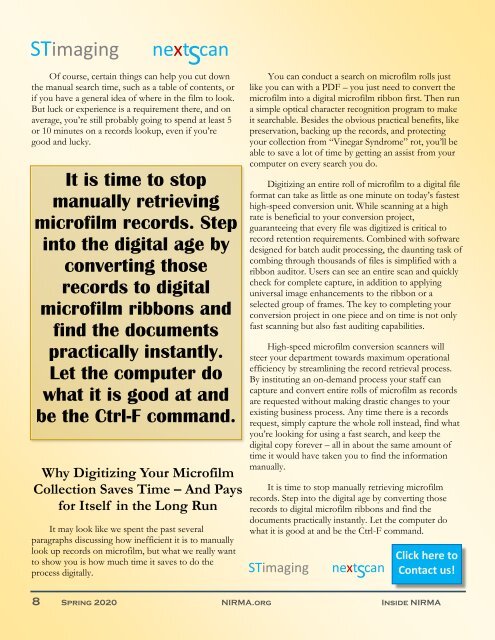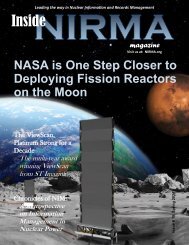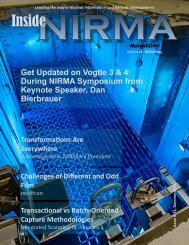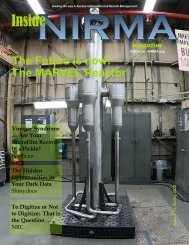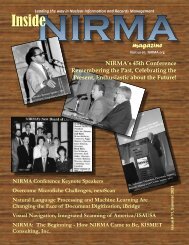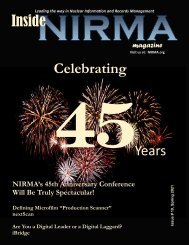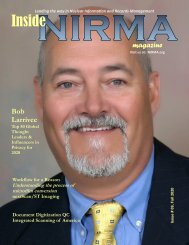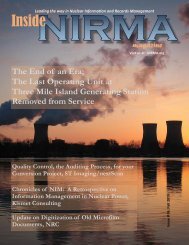Inside NIRMA Spring 2020 FINAL
You also want an ePaper? Increase the reach of your titles
YUMPU automatically turns print PDFs into web optimized ePapers that Google loves.
STimaging<br />
next can<br />
S<br />
Of course, certain things can help you cut down<br />
the manual search time, such as a table of contents, or<br />
if you have a general idea of where in the film to look.<br />
But luck or experience is a requirement there, and on<br />
average, you’re still probably going to spend at least 5<br />
or 10 minutes on a records lookup, even if you’re<br />
good and lucky.<br />
It is time to stop<br />
manually retrieving<br />
microfilm records. Step<br />
into the digital age by<br />
converting those<br />
records to digital<br />
microfilm ribbons and<br />
find the documents<br />
practically instantly.<br />
Let the computer do<br />
what it is good at and<br />
be the Ctrl-F command.<br />
Why Digitizing Your Microfilm<br />
Collection Saves Time – And Pays<br />
for Itself in the Long Run<br />
It may look like we spent the past several<br />
paragraphs discussing how inefficient it is to manually<br />
look up records on microfilm, but what we really want<br />
to show you is how much time it saves to do the<br />
process digitally.<br />
You can conduct a search on microfilm rolls just<br />
like you can with a PDF – you just need to convert the<br />
microfilm into a digital microfilm ribbon first. Then run<br />
a simple optical character recognition program to make<br />
it searchable. Besides the obvious practical benefits, like<br />
preservation, backing up the records, and protecting<br />
your collection from “Vinegar Syndrome” rot, you’ll be<br />
able to save a lot of time by getting an assist from your<br />
computer on every search you do.<br />
Digitizing an entire roll of microfilm to a digital file<br />
format can take as little as one minute on today’s fastest<br />
high-speed conversion unit. While scanning at a high<br />
rate is beneficial to your conversion project,<br />
guaranteeing that every file was digitized is critical to<br />
record retention requirements. Combined with software<br />
designed for batch audit processing, the daunting task of<br />
combing through thousands of files is simplified with a<br />
ribbon auditor. Users can see an entire scan and quickly<br />
check for complete capture, in addition to applying<br />
universal image enhancements to the ribbon or a<br />
selected group of frames. The key to completing your<br />
conversion project in one piece and on time is not only<br />
fast scanning but also fast auditing capabilities.<br />
High-speed microfilm conversion scanners will<br />
steer your department towards maximum operational<br />
efficiency by streamlining the record retrieval process.<br />
By instituting an on-demand process your staff can<br />
capture and convert entire rolls of microfilm as records<br />
are requested without making drastic changes to your<br />
existing business process. Any time there is a records<br />
request, simply capture the whole roll instead, find what<br />
you’re looking for using a fast search, and keep the<br />
digital copy forever – all in about the same amount of<br />
time it would have taken you to find the information<br />
manually.<br />
It is time to stop manually retrieving microfilm<br />
records. Step into the digital age by converting those<br />
records to digital microfilm ribbons and find the<br />
documents practically instantly. Let the computer do<br />
what it is good at and be the Ctrl-F command.<br />
STimaging<br />
S<br />
next can<br />
Click here to<br />
Contact us!<br />
8 <strong>Spring</strong> <strong>2020</strong> <strong>NIRMA</strong>.org <strong>Inside</strong> <strong>NIRMA</strong>


